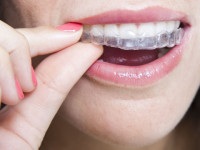Orthodontic Treatment Advances: Braces Then And Now by Caroline Leopold
Modern orthodontic treatment has improved in many exciting ways in just one generation. Orthodontic appliances (or braces) now have a more appealing appearance, and can even be hidden from view entirely. Similar advances have improved the performance of these appliances as well, which often means less physical pressure and shorter treatment times. Consumers ultimately have more options and flexibility in their orthodontic appliances – leading to a more pleasant and satisfying treatment experience.
Better Looking
Braces of the past were almost always developed with the same material – stainless steel – and attached the front surfaces of the teeth. Now, you have options such as ceramic braces, which use tooth-colored brackets that look more natural. You may also have braces applied to the back of the teeth, known today as lingual braces. Keep in mind these new materials may have drawbacks depending on the item. Although lingual braces are invisible, according to 1-800-DENTIST, they are also more expensive, slower in allowing your teeth to adjust and not right for all patients. Ceramic braces can also stain or break, so following proper oral care routines is important through regular brushing, flossing and using a fluoride mouthwash.
Better Performance and Less Pain
While the appearance of braces has improved, there are other enhancements that are not as well known. It used to be that braces' brackets and arch wires were always made of stainless steel, which is an inexpensive material that makes orthodontic treatment affordable. These brackets attach to arch wires, which move the teeth through tension. However, a drawback of stainless steel arch wires is they stretch and wear out, requiring the orthodontist to replace and tighten the wires more frequently.More orthodontists have adopted the use of nickel- or copper-titanium for the arch wires that, as offered by Mary C. Trahar, DDS, PA, apply pressure to the brackets and move the teeth through natural body heat. These metal alloys are temperature-sensitive and tighten when exposed to the mouth's warm temperature. The pressure on the teeth using arch wires made of these metals is more moderate, which means less pain at the beginning of treatment and during adjustment. Further, these metals are more durable, meaning fewer trips to the orthodontist.
More Options for Different Needs
Another major advance is the development of removable appliances or aligners. Their transparent material makes these clear appliances less noticeable, though they can be removed completely for eating, brushing and flossing. Although aligners can be more expensive and less effective in more involved conditions, this may be an option for adults with minor alignment problems.Orthodontic appliances of today have ample variety. Consumers have more options to straighten their teeth than ever before, and each orthodontic procedure can provide appliances that are more attractive, effective and durable.
Source: Orthodontic Treatment Advances: Braces Then and Now
Source Link: http://www.colgate.com/en/us/oc/oral-health/cosmetic-dentistry/adult-orthodontics/article/SW-281474979381140












